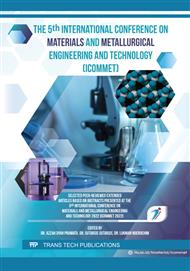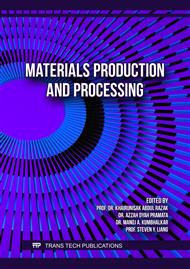[1]
D. Brough and H. Jouhara, "The aluminium industry: A review on state-of-the-art technologies, environmental impacts and possibilities for waste heat recovery," Int. J. Thermofluids, vol. 1–2,(2020).
DOI: 10.1016/j.ijft.2019.100007
Google Scholar
[2]
I. Boukerche, S. Djerad, L. Benmansour, L. Tifouti, and K. Saleh, "Degradability of aluminum in acidic and alkaline solutions," Corros. Sci., vol. 78, p.343–352,(2014).
DOI: 10.1016/j.corsci.2013.10.019
Google Scholar
[3]
V. Branzoi, F. Golgovici, and F. Branzoi, "Aluminium corrosion in hydrochloric acid solutions and the effect of some organic inhibitors," Mater. Chem. Phys., vol. 78, no. 1, p.122–131, (2003).
DOI: 10.1016/s0254-0584(02)00222-5
Google Scholar
[4]
E. Elsarrag, A. Elhoweris, and Y. Alhorr, "The production of hydrogen as an alternative energy carrier from aluminium waste," Energy. Sustain. Soc., vol. 7, no. 1, (2017).
DOI: 10.1186/s13705-017-0110-7
Google Scholar
[5]
X. Wang, G. Li, and R. K. Eckhoff, "Kinetics study of hydration reaction between aluminum powder and water based on an improved multi-stage shrinking core model," Int. J. Hydrogen Energy, vol. 46, no. 67, p.33635–33655, (2021).
DOI: 10.1016/j.ijhydene.2021.07.191
Google Scholar
[6]
Y. Yavor, "Aluminum-water reaction mechanism – modeling of the different reaction stages," 14th Int. Energy Convers. Eng. Conf. 2016, no. July 2016, (2016).
DOI: 10.2514/6.2016-5021
Google Scholar
[7]
M. A. Coronel-García, J. G. Salazar-Barrera, J. J. Malpica-Maldonado, A. L. Martínez-Salazar, and J. A. Melo-Banda, "Hydrogen production by aluminum corrosion in aqueous hydrochloric acid solution promoted by sodium molybdate dihydrate," Int. J. Hydrogen Energy, vol. 45, no. 26, p.13693–13701, (2020).
DOI: 10.1016/j.ijhydene.2020.01.122
Google Scholar
[8]
Zhen Li, Miao Gong, Mengqi Wang, Aixin Feng, Linlu Wang, Peiyong Ma, Shoujun Yuan, "Influence of AlCl3 and oxidant catalysts on hydrogen production from the supercritical water gasification of dewatered sewage sludge and model compounds," Int. J. Hydrogen Energy, vol. 46, no. 61, p.31262–31274, (2021).
DOI: 10.1016/j.ijhydene.2021.07.028
Google Scholar
[9]
A. A. El-Meligi, "Hydrogen production by aluminum corrosion in hydrochloric acid and using inhibitors to control hydrogen evolution," Int. J. Hydrogen Energy, vol. 36, no. 17, p.10600–10607, (2011).
DOI: 10.1016/j.ijhydene.2011.05.111
Google Scholar
[10]
Wang S, Zhu L, Zhang L, Zhang X, Wang X, Ge M, Li X, Zou M, "Preparation of Al-3Ga-3In-3Sn Alloy Powder by Coupling Alloying and Ball Milling and Its Application on High-Rate Hydrogen Generation at Room Temperature," Metals, vol. 11, no. 11. (2021).
DOI: 10.3390/met11111704
Google Scholar
[11]
X. Salueña-Berna, M. Marín-Genescà, L. M. Vidal, and J. M. Dagà-Monmany, "Waste aluminum application as energy valorization for hydrogen fuel cells for mobile low power machines applications," Materials (Basel)., vol. 14, no. 23, (2021).
DOI: 10.3390/ma14237323
Google Scholar
[12]
S. Barzgar, B. Lothenbach, M. Tarik, A. Di Giacomo, and C. Ludwig, "The effect of sodium hydroxide on Al uptake by calcium silicate hydrates (CSH)," J. Colloid Interface Sci., vol. 572, p.246–256, (2020).
DOI: 10.1016/j.jcis.2020.03.057
Google Scholar
[13]
F. Zupanič, M. Steinacher, S. Žist, and T. Bončina, "Microstructure and properties of a novel Al-Mg-Si alloy aa 6086," Metals (Basel)., vol. 11, no. 2, p.1–14, (2021).
DOI: 10.3390/met11020368
Google Scholar
[14]
R. Sinha, S. Basu, and A. K. Meikap, "Investigation of dielectric and electrical behavior of Mn doped YCrO3 nanoparticles synthesized by the sol gel method," Phys. E Low-Dimensional Syst. Nanostructures, vol. 69, p.47–55, (2015).
DOI: 10.1016/j.physe.2015.01.010
Google Scholar
[15]
Y. Hu, Q. Ouyang, B. Zhao, and L. Zhang, "Microstructural Characterization and Phase Diagram Calculation of a Less Known Al–Fe–Mn–Si Phase in a SiCp/2014Al Composite," Microsc. Microanal., vol. 25, no. 4, p.859–865,(2019).
DOI: 10.1017/s1431927619000618
Google Scholar
[16]
P. Godart, J. Fischman, K. Seto, and D. Hart, "Hydrogen production from aluminum-water reactions subject to varied pressures and temperatures," Int. J. Hydrogen Energy, vol. 44, no. 23, p.11448–11458, (2019).
DOI: 10.1016/j.ijhydene.2019.03.140
Google Scholar
[17]
S. Prabu and H. W. Wang, "Improved hydrogen generation from Al/water reaction using different synthesized Al(OH)3 catalyst crystalline phases," Int. J. Energy Res., vol. 45, no. 6, p.9518–9529, Jan.(2021).
DOI: 10.1002/er.6478
Google Scholar
[18]
W.-Z. Gai, X. Zhang, Y. Yang, and Z.-Y. Deng, "Effect of crystalline phases of aluminum hydroxide catalysts on Al‐water reaction," Int. J. Energy Res., vol. 44, Feb.(2020).
DOI: 10.1002/er.5238
Google Scholar
[19]
X. Wang, G. Li, and R. K. Eckhoff, "Kinetics study of hydration reaction between aluminum powder and water based on an improved multi-stage shrinking core model," Int. J. Hydrogen Energy, vol. 46, no. 67, p.33635–33655, (2021).
DOI: 10.1016/j.ijhydene.2021.07.191
Google Scholar
[20]
W. Z. Gai, W. H. Liu, Z. Y. Deng, and J. G. Zhou, "Reaction of Al powder with water for hydrogen generation under ambient condition," Int. J. Hydrogen Energy, vol. 37, no. 17, p.13132–13140, (2012).
DOI: 10.1016/j.ijhydene.2012.04.025
Google Scholar
[21]
S. Prabu and H.-W. Wang, "Hydrogen generation from the reaction of Al and H2O using a synthesized Al(OH)3 nanoparticle catalyst: the role of urea," Catal. Sci. Technol., vol. 11, no. 13, p.4636–4649, (2021).
DOI: 10.1039/d1cy00534k
Google Scholar



